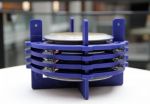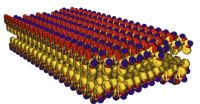(Press-News.org) A gene crucial for brain and heart development may also be associated with sudden unexplained death in epilepsy (SUDEP), the most common cause of early mortality in epilepsy patients.
Scientists at The University of Texas MD Anderson Cancer Center have created a new animal model for SUDEP and have shown that mice who have a partial deficiency of the gene SENP2 (Sentrin/SUMO-specific protease 2) are more likely to develop spontaneous seizures and sudden death. The finding occurred when observing mice originally bred for studying a link between SENP2 deficiency and cancer.
"SENP2 is highly present in the hippocampus, a critical brain region for seizure genesis," said Edward Yeh, M.D., chair of cardiology at MD Anderson. "Understanding the genetic basis for SUDEP is crucial given that the rate of sudden death in epilepsy patients is 20-fold that of the general population, with SUDEP the most common epilepsy-related cause of death."
Yeh's findings were published in this month's issue of Neuron.
Although it's not yet known what causes SUDEP in humans, inactivation of potassium channels genes have been linked to SUDEP in animal models. Potassium channels are found in most cell types and control a large variety of cell functions.
"These animal models demonstrated an important connection between the brain and heart. However, it remains unclear whether seizure and sudden death are two separate manifestations of potassium channel deficiency in the brain and the heart, or whether seizures predispose the heart to lethal cardiac arrhythmia," said Yeh.
The study revealed that when SENP2 was deficient in the brain, seizures activated a part of the nervous system responsible for regulating the heart's electrical system. This resulted in a phenomenon known as atrioventricular conduction block, which effectively slowed down and then stopped the heart.
Yeh's team observed that the SENP2-deficient mice appeared normal at birth, but by 6 to 8 weeks, experienced convulsive seizures, and then sudden death. He believes the reason may lie with protein modifiers called SUMO. SENP2 deficiency results in a process known as hyper-SUMOylation, which dramatically impacts potassium channels in the brain.
"One of the channels, Kv7, is significantly diminished or 'closed' due to the lack of SENP2," said Yeh. "In mice this led to seizures and cardiac arrest."
In humans, the good news is that an FDA-approved drug, retigabine works by "opening" the Kv7 channel. The therapy was developed for treating partial-onset seizures. The findings in Yeh's new mouse model clearly demonstrate a previously unknown cause of SUDEP, which may open up new opportunities for study and treatment in the future.
INFORMATION:
Other MD Anderson study participants included Yitao Qi, Ph.D. and Jingxiong Wang, M.D., Ph.D. in the department of cardiology, and De-Pei Li, M.D., Sho-Rui Chen, M.D. and Hui-Lin Pan, M.D., Ph.D. in the department of anesthesiology and perioperative medicine. Collaborative institutions included Texas Heart Institute, Baylor College of Medicine, and The University of Texas Health Science Center at Houston.
The study was funded by the McNair Medical Foundation (NS29709, NS0769 and HL077400) and the National Natural Science Foundation of China (91019021).
Seizures and sudden death: When SUMO 'wrestles' potassium channels
Study results in new understanding of common cause of epilepsy death
2014-09-03
ELSE PRESS RELEASES FROM THIS DATE:
Researchers unlock new mechanism in pain management
2014-09-03
It's in the brain where we perceive the unpleasant sensations of pain, and researchers have long been examining how calcium channels in the brain and peripheral nervous system contribute to the development of chronic pain conditions.
Neuroscientist Gerald Zamponi, PhD, and his team at the University of Calgary's Hotchkiss Brain Institute have discovered a new mechanism that can reverse chronic pain. Using an animal model, their research has found that pain signals in nerve cells can be shut off by interfering with the communication of a specific enzyme with calcium ...
Changing temperature powers sensors in hard-to-reach places
2014-09-03
A centuries-old clock built for a king is the inspiration for a group of computer scientists and electrical engineers who hope to harvest power from the air.
The clock, powered by changes in temperature and atmospheric pressure, was invented in the early 17th century by a Dutch builder. Three centuries later, Swiss engineer Jean Leon Reutter built on that idea and created the Atmos mechanical clock that can run for years without needing to be wound manually.
Now, University of Washington researchers have taken inspiration from the clock's design and created a power ...
Tweets during 2013 Colorado floods gave engineers valuable data on infrastructure damage
2014-09-03
Tweets sent during last year's massive flooding on Colorado's Front Range were able to detail the scope of damage to the area's infrastructure, according to a study by the University of Colorado Boulder.
The findings can help geotechnical and structural engineers more effectively direct their reconnaissance efforts after future natural disasters—including earthquakes, tsunamis and tornadoes—as well as provide them data that might otherwise be lost due to rapid cleanup efforts.
"Because the flooding was widespread, it impacted many canyons and closed off access to communities ...
Galapagos invasion is global warning
2014-09-03
A new study led by a PhD researcher at The University of Western Australia has revealed that parts of the iconic Galapagos Islands have been overrun by invasive plants from other parts of the world.
"People may be shocked that a place considered so iconic for biodiversity is so overrun with weeds in some areas despite ongoing control effort by National Park rangers, but this is really a global story," lead author from the UWA School of Plant Biology Mandy Trueman said.
The results published in the open access journal Neobiota confirm that in the humid highland part ...
Peptoid nanosheets at the oil-water interface
2014-09-03
From the people who brought us peptoid nanosheets that form at the interface between air and water, now come peptoid nanosheets that form at the interface between oil and water. Scientists at the U.S. Department of Energy (DOE)'s Lawrence Berkeley National Laboratory (Berkeley Lab) have developed peptoid nanosheets - two-dimensional biomimetic materials with customizable properties - that self-assemble at an oil-water interface. This new development opens the door to designing peptoid nanosheets of increasing structural complexity and chemical functionality for a broad ...
How well does bariatric surgery work?
2014-09-03
SEATTLE—The number of bariatric surgeries done each year in the United States has ballooned. Now, in an August 27 state-of-the-art review in The BMJ and a September 3 editorial in JAMA, David Arterburn, MD, MPH, weighs the evidence on the benefits and risks of the various types of this surgery.
"It's critical that we find effective—and cost-effective—ways to treat severe obesity," said Dr. Arterburn, an associate investigator at Group Health Research Institute, a Group Health physician, and an affiliate associate professor of medicine at the University of Washington School ...
Are human breast milk microbiomes 'neutral'?
2014-09-03
Human breast milk is considered the most ideal source of nutrition for infants and it should have played a critical role in the evolution and civilizations of human beings. Unlike our intuitive perception, human milk contains a large number of bacterial species, including some opportunistic pathogens of humans. This phenomenon comes as no surprise to scientists and physicians.
Indeed, the existence of milk microbiome is considered to be the result of co-evolutionary and co-adaptive interactions between the microbiome and human host. Furthermore, the dynamic balance in ...
The Lancet Respiratory Medicine: Household air pollution puts more than 1 in 3 people worldwide at risk of ill health and early death
2014-09-03
Household air pollution, caused by the use of plant-based or coal fuel for cooking, heating, and lighting, is putting nearly three billion people worldwide at risk of ill health and early death, according to a new Commission, published in The Lancet Respiratory Medicine journal.
A third of the world's population use plant-based solid fuels such as wood or charcoal, or coal, to cook, heat, and light their homes, primarily in Asia and Africa. These smoky, dirty fuels are often used in an open fire or simple stove, resulting in high levels of household air pollution in poorly ...
Researchers reveal carbon emissions of PlayStation 3 game distribution
2014-09-03
It's not always true that digital distribution of media will have lower carbon emissions than distribution by physical means, at least when file sizes are large.
That's the conclusion of a study published in Yale's Journal of Industrial Ecology that looked at the carbon footprint of games for consoles such as PlayStation®3. Researchers found that Blu-ray Discs delivered via retail stores caused lower greenhouse gas emissions than game files downloaded over broadband Internet. For their analysis, the investigators estimated total carbon equivalent emissions for an 8.8-gigabyte ...
'Prepped' by tumor cells, lymphatic cells encourage breast cancer cells to spread
2014-09-03
Breast cancer cells can lay the groundwork for their own spread throughout the body by coaxing cells within lymphatic vessels to send out tumor-welcoming signals, according to a new report by Johns Hopkins scientists.
Writing in the Sept. 2 issue of Nature Communications, the researchers describe animal and cell-culture experiments that show increased levels of so-called signaling molecules released by breast cancer cells. These molecules cause lymphatic endothelial cells (LECs) in the lungs and lymph nodes to produce proteins called CCL5 and VEGF. CCL5 attracts tumor ...
LAST 30 PRESS RELEASES:
B cells transiently unlock their plasticity, risking lymphoma development
Advanced AI dodel predicts spoken language outcomes in deaf children after cochlear implants
Multimodal imaging-based cerebral blood flow prediction model development in simulated microgravity
Accelerated streaming subgraph matching framework is faster, more robust, and scalable
Gestational diabetes rose every year in the US since 2016
OHSU researchers find breast cancer drug boosts leukemia treatment
Fear and medical misinformation regarding risk of progression or recurrence among patients with breast cancer
Glucagonlike peptide-1 receptor agonists and asthma risk in adolescents with obesity
Reviving dormant immunity: Millimeter waves reprogram the immunosuppressive microenvironment to potentiate immunotherapy without obvious side effects
Safety decision-making for autonomous vehicles integrating passenger physiological states by fNIRS
Fires could emit more air pollution than previously estimated
A new way to map how cells choose their fate
Numbers in our sights affect how we perceive space
SIMJ announces global collaborative book project in commemoration of its 75th anniversary
Air pollution exposure and birth weight
Obstructive sleep apnea risk and mental health conditions among older adults
How talking slows eye movements behind the wheel
The Ceramic Society of Japan’s Oxoate Ceramics Research Association launches new international book project
Heart-brain connection: international study reveals the role of the vagus nerve in keeping the heart young
Researchers identify Rb1 as a predictive biomarker for a new therapeutic strategy in some breast cancers
Survey reveals ethical gaps slowing AI adoption in pediatric surgery
Stimulant ADHD medications work differently than thought
AI overestimates how smart people are, according to HSE economists
HSE researchers create genome-wide map of quadruplexes
Scientists boost cell "powerhouses" to burn more calories
Automatic label checking: The missing step in making reliable medical AI
Low daily alcohol intake linked to 50% heightened mouth cancer risk in India
American Meteorological Society announces Rick Spinrad as 2026 President-Elect
Biomass-based carbon capture spotlighted in newly released global climate webinar recording
Illuminating invisible nano pollutants: advanced bioimaging tracks the full journey of emerging nanoscale contaminants in living systems
[Press-News.org] Seizures and sudden death: When SUMO 'wrestles' potassium channelsStudy results in new understanding of common cause of epilepsy death




